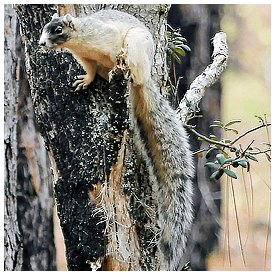Landowner Assistance Program lowers cost of habitat restoration
Fox Squirrels: Denizens of the Longleaf Forest
By Arlo Kane, regional coordinator,
Florida Fish and Wildlife Conservation Commission
Special to Historic City News
Recently, I was touring a friend’s property in the Florida sandhills through beautiful older longleaf pines, with an open understory that is regularly burned. As we came around the corner, two fox squirrels bounded towards the nearest large pine. In a minute, both had found a tree they liked and were gone from sight. I don’t know about you, but I never tire of seeing fox squirrels. But I must admit it does not happen as often as I would like.
Southeastern fox squirrels are declining because over the years 97 percent of the mature longleaf pine forests have been lost. Like many other denizens of the longleaf forest, fox squirrels prefer widely spaced mature pines with a few scattered large oaks with both an open understory and mid-story. This is their ideal habitat.
Fox squirrels occur over most of the central and eastern United States, with the exception of the states northeast of New York. Their color phases range from gray to black to red. Fox squirrels are the largest but least arboreal tree squirrel species in North America. The fox squirrel is about twice as large as the more common gray squirrel. Its larger size is probably an adaption to living in an open savanna-like habitat with widely spaced trees.
The fox squirrel’s larger size is an advantage for travelling overland as opposed to gray squirrels that travel through the canopy of dense forests where they can move from tree to tree without having to go to the ground. Fox squirrels’ larger size also gives them the strength to crack open green longleaf pinecones – a feat that the average gray squirrel cannot achieve.
Wildlife researchers have found the most important feature influencing southeastern fox squirrel habitat is tree canopy cover. Too much canopy results in reduced occurrences of fox squirrels. This can happen for several reasons, but the most likely is increased competition with gray squirrels. As hardwoods encroach into the longleaf forest, gray squirrels move in and fox squirrels move out.
While too many hardwoods can favor gray squirrel habitat over fox squirrel habitat, a few clumps of oaks and scattered large oaks are important features of fox squirrel habitat. The oaks provide acorns for fox squirrels’ food and large hardwoods are preferred for daytime refuge. It is not the hardwoods that are the problem, but their density. Too many hardwoods seem to make the habitat unsuitable for fox squirrels and they will move out.
The typical diet for fox squirrels includes acorns, longleaf pine seeds, fruits, insects and fungi. It is the fungi that are their most interesting food source and it may indicate an important relationship between fox squirrels and the longleaf pine forest.
Researchers in the 1970s found evidence of subterranean fungi in the fecal samples of southeastern fox squirrels. They confirmed that small pits in the sandhills had been dug by fox squirrels looking for the fruiting bodies of underground fungi.
Fungi are eaten by many species of wildlife because they supply sufficient amounts of sodium and phosphorous to the diet. But, in the case of these underground fungi, they also are used by tree roots to help provide nutrients to the growing tree. Because spores of the fungi pass through the digestive tract unharmed, fox squirrels are important for moving the fungal spores around the forest and helping newly planted longleaf pines gain important nutrients from the soil.
Fox squirrels can be thought of as an indicator species for a healthy longleaf pine forest. A forest with fox squirrels is healthier than one without.
Managing a longleaf forest generally means using prescribed fire. Prescribed burning on a two to three-year rotation is important for maintaining that open understory and mid-story habitat. In the absence of fire, hardwoods will encroach and eventually make the habitat unsuitable for fox squirrels. Certain oaks such as turkey oaks and southern red oak are tolerant of frequent fire to a degree. They are fine at low density, but what you don’t want is a hardwood forest. Thinning your pine forest to lower densities as soon as feasible is also important to creating good habitat.
“As landowners harvest and replant their forest land, picking the species to replant is important. Often economics is the driving force and may lead landowners to favor slash or loblolly pines over longleaf. If you are interested in fox squirrels, you may want to add in some other considerations to your decision,” Kane told Historic City News local reporters. “Cost share programs through USDA’s Natural Resources Conservation Service programs can help offset the cost of conducting habitat restoration. Contact your Florida Fish and Wildlife Conservation Commission Landowner Assistance Program biologist or local NRCS district conservationist for more information.”
Slash and loblolly pines are not usually burned until the trees are around 12 years of age. A lot of hardwood encroachment can occur in that time. Also, these pines are usually planted at higher densities, which eliminates the open canopy, open understory habitat favored by fox squirrels.
Most slash and loblolly pines are planted on short rotations, which means the pines are harvested before they reach the larger size of a mature timber stand. As tree height and diameter increase, preference by fox squirrels increase. So, short rotations may not allow the trees to reach a size that attracts fox squirrels.
How can you help restore southeastern fox squirrels in Florida? By restoring your land to a more open low density longleaf pine habitat. Using forest management practices such as burning and thinning as well as retaining mature hardwoods within a mature longleaf pine forest are good practices.
Discover more from HISTORIC CITY NEWS
Subscribe to get the latest posts sent to your email.




